
We all know that in theory, outdoor air is actually cleaner than our indoor air at home. But what if you live in an area with high levels of outdoor air pollution or a really poor outdoor air quality? If your outdoor air quality is poor and you live in a highly polluted area, it can be confusing to hear the advice that opening windows and doors will help reduce toxins in your home.
If your outdoor air isn’t clean and healthy to breathe, you’ll basically just be exchanging one type of toxin for another if you try to naturally ventilate your home. In Minnesota, where I live, it’s very rare to have poor outdoor air quality, but it does happen. Last summer we experienced weeks of poor outdoor air quality from Canadian wildfires that sent smoke down into most of our state.
And so even if you live in an area with great outdoor air quality and you rarely have outdoor air pollution, it’s important to know how to handle your home and habits in case there is a time period where outdoor air pollution can be at dangerous levels. And if you’re someone who lives in a city or area where outdoor air pollution is constantly an issue, then you’ll really want to know how to handle your home and space.
Our homes can truly be a safe space from a multitude of toxins and pollutants. If we create our home spaces in the right way, we can create a space where we give our bodies a much needed reprieve from the pollutants in the outdoor air as well as the toxins that are in the world around us.
When you have poor outdoor air quality, there are a few things that will be different in terms of creating a healthy indoor space. But it’s all the more important to work hard towards this toxin free home to support your body’s health and wellness.
HOW OUTDOOR POLLUTION GETS INTO INDOOR LIVING SPACES
While many new homes boast about being airtight and having very little air coming in or out of the space uncontrolled, many of us live in homes where there is SOME amount of air coming from leaks and gaps around windows, doors, foundations and attics. The air coming in through these small open spaces is never filtered and will contain everything the outdoor air is carrying. In other words, any pollution in the outdoor air makes its way inside without any of the pollution particles being trapped in a filter.
Outdoor air pollution can eventually make its way into our homes through a variety of avenues. First being any sort of venting that we have in our homes that allows fresh air inside. Many homes have a large soft vent tube (makeup air vent) that is open near a utility area of the home and travels to a vent somewhere on the side of your home. This tube is there to bring in fresh air, and well, sometimes it can bring in polluted air too.
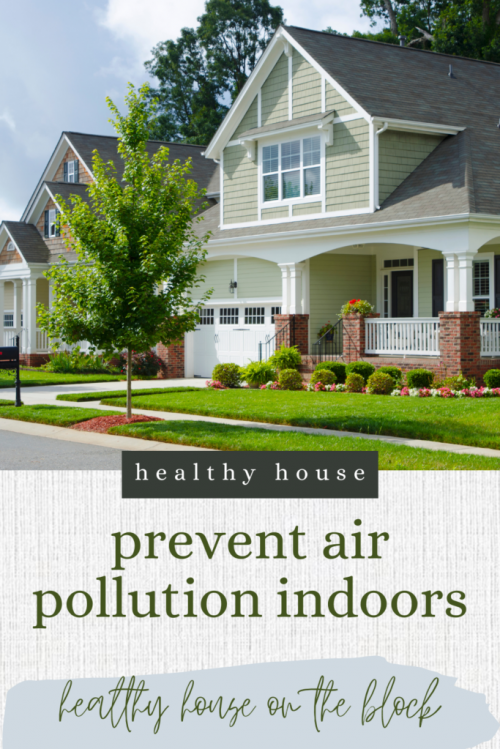
Some homes will have an air exchanger, which is an EXCELLENT addition to ANY healthy home. These air exchangers bring in air through a vent, but the air travels through two filters to catch any particulate matter, dust, dirt and large particles. If you have an air exchanger, the best practices are to (1) use the air exchanger and (2) clean the filters regularly.
Any sort of HVAC unit like a high efficiency furnace, air conditioning units at walls and mini split systems will pull air in from outside as the appliance runs. It’s necessary for these appliances to have air from outside your home to run efficiently, and sometimes, depending on your unit, there is a filter that the air travels through before it enters your home.
And finally, our regular living habits bring in plenty of outdoor air. Every time you open a window or a door, you’re allowing air to come in from the outdoors. Obviously we don’t have filters for our window screens, because they are intended to bring in the highest amount of fresh air possible.
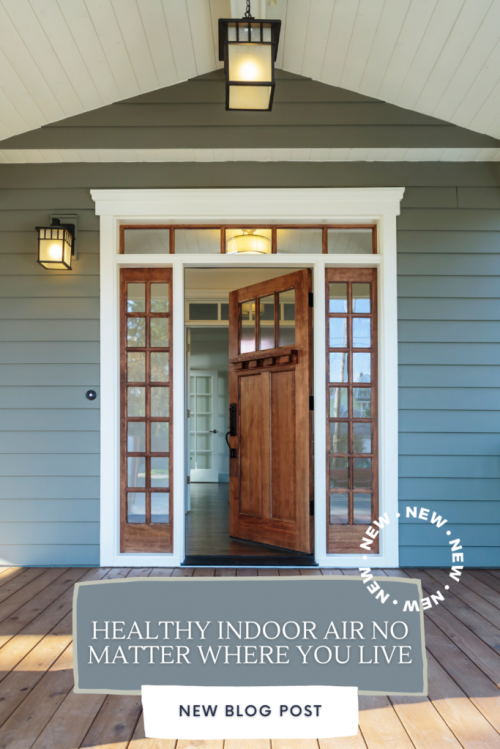
WHERE YOU CAN CHECK YOUR OUTDOOR POLLUTION LEVELS
There are so many ways you check the outdoor air pollution in your area, but probably the easiest and quickest way is to head to www.airnow.gov. You can simply put in your zip code and quickly see what the outdoor air quality around your home may be at currently. Their website has many resources that you can look at if you live in an area where outdoor air pollution is a big problem.
Some apps on your smartphone or smart devices at home will also include an outdoor air quality report with your forecast. This is a great option for planning outdoor activities as well as just knowing what the outdoor air pollution levels are around your home.
A last option would be to use a weather station device that has a sensor outdoors. You can find a weather station that also has the option to sense outdoor air quality as well as temperature, humidity and other climate components. Netatmo is a well respected brand that does include this data and also works with most smart home devices.
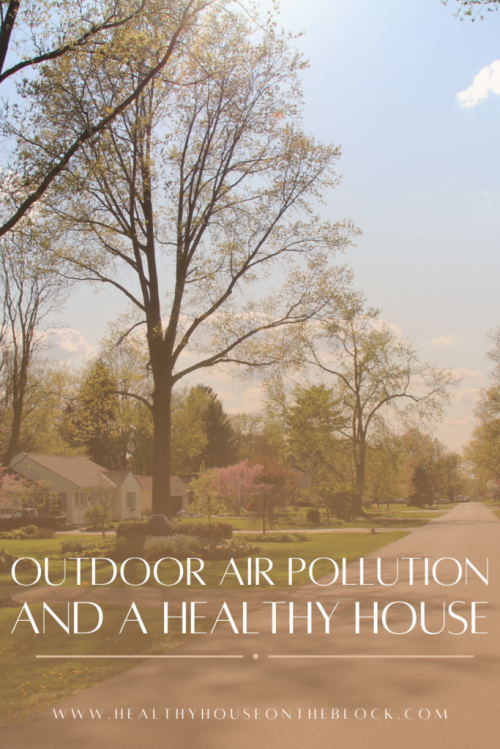
WHY CLEAN AIR AT HOME IS SO IMPORTANT
Obviously clean air to breathe is important, but if you live in an area where the outdoor air pollution is high, your indoor air is even MORE important to keep clean and healthy.
Outdoor air pollution can consist of a number of toxins. The most obvious may be particulate matter, which is large particles and even fine particles. These particles are a mix of solid and liquid particles that we inhale. Most of the particles are invisible, but you can see a haze when the outdoor air quality is extremely poor. Smoke from fires is often a large contributor to this type of air pollution. However it also comes from things like construction, agriculture, fossil fuel factories and motor vehicles. Particulate matter has been linked to development in asthma of children, slowed lung function growth in children and teens, increased risk of cardiovascular disease and increased risk of heart attacks and strokes. (ALA INFORMATION)
Another contributor that is poorly controlled is ozone. You may hear it referred to as it’s older term, “smog”, but it’s essentially the same thing. Tailpipes, smokestacks and other sources of high heat combustion produce nitrogen oxides and VOCs, which cause ozone to develop in our atmosphere. This dangerous form of outdoor air pollution contributes to lower birth weight and lung function of newborns, increased risk of developing asthma in kids and teens, and a higher risk of respiratory disease causing death. (ALA INFORMATION)
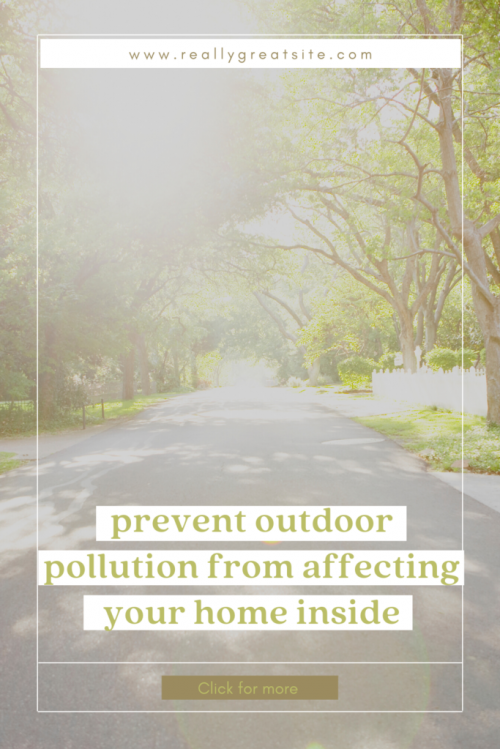
Sometimes power plants, refineries and other manufacturing plants can produce emissions from toxins that are used in production. Toxic air pollutants are not only inhaled, but can also settle into dirt where children play, and settle into waterways where people and fish may drink them. The range of issues from air toxins is vast: cancer, birth defects, nervous system damage, impaired lung function, reduced fertility and cardiovascular system harm. The EPA has a great tool where you can check your zip code for toxic chemicals in the environment around you. (ALA INFORMATION)
And finally, nitrogen dioxide, an air pollutant from gas and diesel, contributes to outdoor air pollution, especially if you live near a major highway or in places with more traffic than most. Nitrogen dioxide contributes to particle pollution as well as chemical reactions that make ozone. It’s been linked to increased asthma attacks, cardiovascular harm, lower birth weights in newborns and increased inflammation of the airways.
By creating an indoor space that is free from these outdoor pollutants, you’re creating a space for your body to have a break and restore. You’re not overloading your immune system and overall body with toxins, which can disrupt hormone production and cause a trickle-down effect of issues.
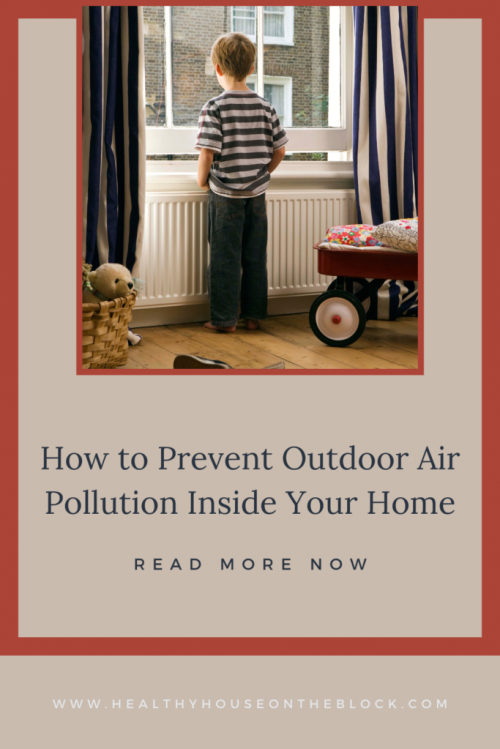
CREATING HEALTHY INDOOR AIR WITH POLLUTED OUTDOOR AIR
You don’t have to live without opening your doors or windows if you live in an area with high levels of outdoor air pollution. But there are smart ways you can change your habits to prevent indoor air from becoming as polluted as the outdoor air.
Closed and Cleaned Windows: If you can manage to keep windows closed as much as possible, this will help reduce the outdoor air pollution that makes its way inside. Obviously this is easier said than done, but in the long run it will help greatly. In addition to keeping your windows closed, make sure that the track and screens get cleaned off regularly. We know that some toxins and pollutants can settle onto surfaces, and our windows and screens are one of those surfaces where toxins and pollutants can sit and then enter our home.
HVAC Filters: Filters on any of your appliances like furnaces, mini split systems, air exchangers and air conditioners should be replaced frequently. Opt for a carbon filter that has a MERV rating of 12 or higher to reduce as many particles as possible. However, remember that the more you filter out with a high quality filter, the more you’ll need to replace the filter. A filter that is blocked with particles and contaminants not only doesn’t do its job very well, but it can also cause damage to your appliance by reducing proper air flow. I love Nordic Pure Air Filters for my home and get them directly from their site.

No Indoor Air Pollution: Whatever you do, make sure you’re not adding to the outdoor air pollution by using products that can contribute to the indoor air pollution problem. This means steering clear of aerosols, candles and synthetic fragrances. It could also mean that you choose natural cleaning solutions rather than cleaning products that use a lot of man-made chemicals and fragrance. By reducing the toxins inside, you’ll also create a place for your body to get a break while it naturally detoxifies other toxins it comes into contact with outside.
Air Purifiers: Air purifiers are a great way to reduce indoor air pollution. They are especially great if you have a lot of outdoor pollution, as typically the micron size of this type of pollutant is larger and more easily filtered out. Running an air purifier will continue to clean the air over and over, reducing particles and pollutants each time. I have loved our MedifyAir Filter (read all about my research and opinions on it here). You can also use my coupon code HHOTB15 for $15 off your purchase. Their HEPA filters work to reduce large particles, smoke particles and microscopic toxins in the air.
Regular Cleaning: Cleaning on a regular basis to reduce dust at home is another way you can simply and easily reduce toxins and air pollution that has settled into your house dust. House dust can be one of the most toxic things about a home, and the great news is that there is a very simple and easy way to remove it without breaking the bank. Opt for a vacuum with a HEPA filter and then don’t forget the corners and behind furniture. You can wet dust on a regular basis to reduce dust and keep it out of your indoor air.
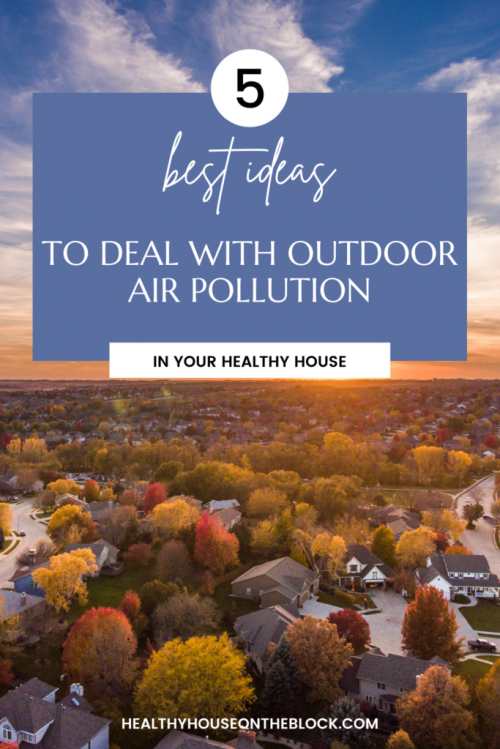
Creating an indoor space that is as free from toxins as possible will give your body a space where it can naturally detoxify without being bombarded with more toxins. It’s a healthy safe haven where you can heal and rebalance. Understanding outdoor air pollution and how it will affect your indoors space is an important part of the puzzle so you know when to let fresh air inside and when to utilize other ventilation techniques to improve indoor air quality.

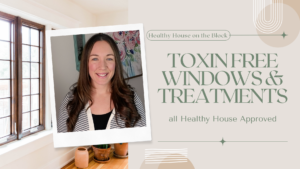


Pingback: Avoid a Sick House and Sick Building Syndrome »